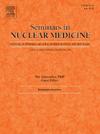Current Developments on [18F]FDG PET/CT in Inflammatory Disorders of the Central Nervous System
IF 5.9
2区 医学
Q1 RADIOLOGY, NUCLEAR MEDICINE & MEDICAL IMAGING
引用次数: 0
Abstract
2-Deoxy-2-[18F]fluoro-D-glucose positron emission tomography (FDG-PET) is widely used to study cerebral glucose metabolism and may be useful in several inflammatory disorders of the central nervous system. Emerging literature suggests that [18F]FDG may be more sensitive to detect abnormalities in auto-immune encephalitis (AIE) in comparison to MRI, especially in NDMA receptor encephalitis. Distinct patterns of regional abnormalities in AIE have been reported, depending on the auto-antibody involved. Predominant findings are hypermetabolism of the mediotemporal lobe and hypometabolism in parietal and occipital lobes. The possibility for whole body imaging in the setting of malignancy screening further strengthens the importance of [18F]FDG PET in AIE when associated with paraneoplastic syndromes. Other inflammatory conditions of the central nervous system where [18]FDG PET may facilitate diagnosis include neurosarcoidosis and potential neuropsychiatric manifestations of systemic lupus erythematodes. More recently, [18F]FDG PET has been used in patients to evaluate postacute sequelae of COVID-19, allowing assessment of specific neuronal impairments at the individual level and determination of time-dependent metabolic alterations.
[18F]FDG PET/CT在中枢神经系统炎症性疾病中的研究进展
2-脱氧-2-[18F]氟- d -葡萄糖正电子发射断层扫描(FDG-PET)被广泛用于研究脑葡萄糖代谢,并可能在中枢神经系统的几种炎症性疾病中有用。新出现的文献表明[18F]FDG可能比MRI更敏感地发现自身免疫性脑炎(AIE)的异常,特别是NDMA受体脑炎。据报道,AIE的不同区域异常模式取决于所涉及的自身抗体。主要表现为中颞叶代谢高,顶叶和枕叶代谢低。在恶性肿瘤筛查的背景下,全身显像的可能性进一步加强了[18F]FDG PET在与副肿瘤综合征相关的AIE中的重要性。[18]FDG PET可能有助于诊断中枢神经系统的其他炎症包括神经结节病和系统性红斑狼疮的潜在神经精神表现。最近,[18F]FDG PET已用于患者评估COVID-19急性后后遗症,可在个体水平上评估特异性神经元损伤并确定时间依赖性代谢改变。
本文章由计算机程序翻译,如有差异,请以英文原文为准。
求助全文
约1分钟内获得全文
求助全文
来源期刊

Seminars in nuclear medicine
医学-核医学
CiteScore
9.80
自引率
6.10%
发文量
86
审稿时长
14 days
期刊介绍:
Seminars in Nuclear Medicine is the leading review journal in nuclear medicine. Each issue brings you expert reviews and commentary on a single topic as selected by the Editors. The journal contains extensive coverage of the field of nuclear medicine, including PET, SPECT, and other molecular imaging studies, and related imaging studies. Full-color illustrations are used throughout to highlight important findings. Seminars is included in PubMed/Medline, Thomson/ISI, and other major scientific indexes.
 求助内容:
求助内容: 应助结果提醒方式:
应助结果提醒方式:


